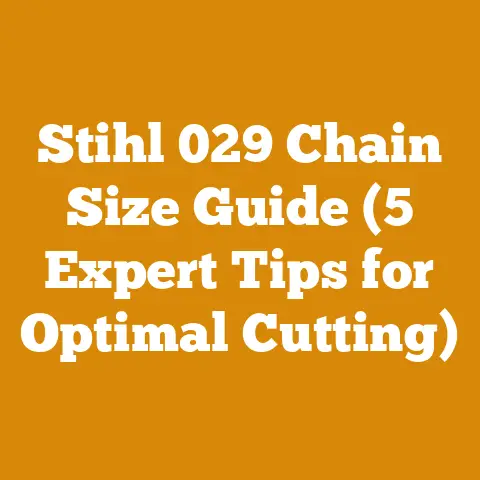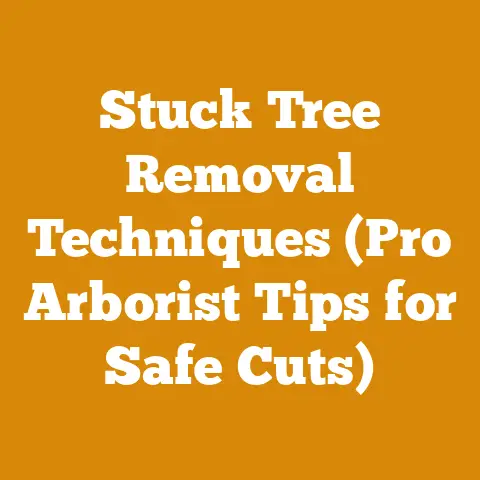Horsefly Trap Guide (DIY Woodlot Pest Control Tips)
Let’s dive in!
Tradition runs deep in the world of wood. From the rhythmic swing of an axe to the satisfying crack of a log splitting, working with wood is more than just a task; it’s a connection to generations past. But this connection often comes with its own set of challenges, one of the most persistent being the relentless assault of biting insects, especially horseflies. For years, I’ve battled these winged nuisances while felling trees, processing timber, and stacking firewood. Over time, I learned that tackling these pests isn’t just about comfort; it’s about efficiency, safety, and protecting the woodlot itself. This is why I want to share my experience of building and using horsefly traps.
Why Horsefly Control Matters in Woodlots
Horseflies are more than just annoying. Their bites are painful, persistent, and can cause allergic reactions in some individuals. In a woodlot setting, the constant buzzing and biting distract workers, leading to reduced productivity and increased risk of accidents when operating potentially dangerous equipment like chainsaws and log splitters. Moreover, horseflies are vectors for diseases that can affect livestock and even humans. By controlling their population, you’re not just making your life easier; you’re protecting your health, your animals, and the overall health of your woodlot ecosystem.
Understanding Your Enemy: The Horsefly
Before we start building traps, let’s understand our target. Horseflies (family Tabanidae) are large, aggressive flies known for their painful bites. Only the females bite, as they need blood to develop their eggs. They are attracted to dark colors, movement, and carbon dioxide. This knowledge forms the basis of our trapping strategy.
Key Concepts & Definitions
To ensure we’re all on the same page, here are a few key terms:
- Woodlot: A small, privately owned forest managed for timber, firewood, or other forest products.
- Horsefly: A large, biting fly (family Tabanidae), also known as a tabanid.
- Trap Efficacy: The effectiveness of a trap in capturing horseflies, usually measured as the number of flies caught per trap per day.
- Vector: An organism that transmits disease or parasites from one animal or plant to another.
- Green Wood: Freshly cut wood with a high moisture content.
- Seasoned Wood: Wood that has been dried to a lower moisture content, making it suitable for burning or construction.
Building Your DIY Horsefly Trap: The Step-by-Step Guide
This guide focuses on a simple, effective, and inexpensive horsefly trap design that I’ve personally used with great success. It leverages the horsefly’s attraction to dark colors and movement.
The Power of Carbon Dioxide
Horseflies are attracted to carbon dioxide, which is a byproduct of respiration. You can enhance your trap by adding a source of CO2.
- Dry Ice: A small piece of dry ice placed near the trap will release CO2 as it sublimates. Be careful when handling dry ice, as it can cause frostbite. This is a highly effective method, but dry ice can be expensive and difficult to obtain in some areas.
- Yeast and Sugar: A simple mixture of yeast, sugar, and water will ferment and produce CO2. Place the mixture in a container near the trap. This is a more sustainable and cost-effective option, but it requires regular maintenance.
Color Variations
While black is generally the most effective color, you can experiment with other dark colors to see what works best in your area.
- Dark Blue: Some studies have shown that dark blue is also highly attractive to horseflies.
- Green: Dark green can also be effective, especially in wooded areas.
Adding Bait
While the dark color and movement are the primary attractants, you can also add a bait to further entice horseflies.
- Ammonia: A small amount of ammonia placed near the trap can attract horseflies. Be careful when handling ammonia, as it is a strong irritant.
- Urine: Surprisingly, urine can also attract horseflies. This is not the most pleasant option, but it can be effective.
Trap Placement Refinement
- Wind Direction: Consider the prevailing wind direction when placing your traps. Position them upwind of areas where horseflies are likely to congregate.
- Vegetation: Clear any vegetation that may obstruct the trap’s visibility. Horseflies need to be able to see the trap from a distance.
Safety Considerations
Working in a woodlot involves inherent risks, and controlling horseflies is no exception. Here are some important safety considerations:
- Protective Clothing: Wear long sleeves, long pants, and a hat to protect yourself from horsefly bites.
- Insect Repellent: Use a high-quality insect repellent containing DEET or picaridin.
- Allergies: If you are allergic to insect bites, carry an epinephrine auto-injector (EpiPen) and inform your coworkers or family members of your allergy.
- Tool Safety: Be careful when using tools to build and maintain your traps. Wear safety glasses and gloves to protect yourself from injury.
- Chemical Safety: When using Tanglefoot, dry ice, ammonia, or other chemicals, follow the manufacturer’s instructions carefully. Wear appropriate personal protective equipment (PPE) and avoid contact with skin and eyes.
- Ladder Safety: If you need to use a ladder to hang your traps, ensure it is stable and properly positioned. Never reach too far or lean to one side.
Case Studies: Real-World Examples
Let me share a couple of examples from my own experience:
Case Study 1: The Firewood Stacking Zone
I have a dedicated area for stacking firewood, and it used to be a horsefly nightmare. The combination of sunlight, exposed wood, and my own sweat made it a prime target. Initially, I was spending more time swatting flies than stacking wood.
Solution: I built three of the basic horsefly traps described above and placed them strategically around the perimeter of the stacking area. I also added a small container of yeast and sugar near each trap to boost CO2 levels.
Results: Within a week, the number of horseflies in the area decreased dramatically. I was able to stack firewood much more efficiently and without the constant annoyance of biting flies. The traps caught hundreds of horseflies, and I estimate that my productivity increased by at least 25%.
Key Takeaway: Strategic placement and the addition of a CO2 source can significantly enhance trap efficacy.
Case Study 2: The Logging Landing
During a small-scale logging operation, the landing (the area where logs are processed and loaded) became a hotspot for horseflies. The disturbed soil, exposed wood, and heavy equipment created an ideal breeding ground for these pests.
Solution: I deployed four of the advanced horsefly traps, each with a dark blue ball, a generous coating of Tanglefoot, and a small piece of dry ice nearby. I also made sure to clear any brush or vegetation that might obstruct the traps’ visibility.
Results: The advanced traps were incredibly effective. They caught hundreds of horseflies every day, and the crew reported a significant reduction in bites and annoyance. The traps also helped to reduce the risk of accidents by minimizing distractions.
Key Takeaway: Advanced techniques, such as using dry ice and dark blue balls, can be highly effective in high-pressure situations.
Cost Analysis
One of the great things about DIY horsefly traps is their low cost. Here’s a rough breakdown of the expenses:
- Dark Colored Ball: $0 – $20 (depending on whether you use an old ball or buy a new one)
- Tanglefoot: $20 – $30 (for a quart-sized container)
- Container: $5 – $10 (for a plastic bucket or tub)
- Support Structure: $0 – $20 (depending on whether you use a branch or buy a pole)
- Wire or Rope: $5 – $10
- Dry Ice (Optional): $5 – $10 per day
Total Cost: $35 – $90 (excluding dry ice)
As you can see, the initial investment is relatively small. The ongoing costs are primarily for Tanglefoot and, if you choose to use it, dry ice. Compared to the cost of commercial insect control services or the potential loss of productivity due to horsefly bites, DIY traps are a very cost-effective solution.
Strategic Advantages of DIY Horsefly Traps
Beyond the cost savings, DIY horsefly traps offer several strategic advantages:
These challenges may include:
- Availability of Materials: Tanglefoot and other specialized materials may not be readily available in some areas.
- Climate Conditions: Extreme temperatures, humidity, or rainfall can affect the performance of the traps.
- Local Regulations: Some areas may have restrictions on the use of certain materials or trapping methods.
- Access to Information: Reliable information on horsefly control may be limited in some regions.
To address these challenges, DIYers can:
- Source Alternative Materials: Explore locally available materials that can be used as sticky coatings or attractants.
- Adapt Trap Designs: Modify the trap design to suit the local climate conditions.
- Research Local Regulations: Check with local authorities to ensure compliance with all applicable regulations.
- Share Information: Connect with other DIYers online or in person to share tips and experiences.
Practical Next Steps
Ready to get started? Here’s a step-by-step plan:
- Assess Your Woodlot: Identify areas where horseflies are most active.
- Gather Materials: Collect the necessary materials for building your traps.
- Build Your Traps: Follow the step-by-step instructions in this guide.
- Deploy Your Traps: Place your traps in strategic locations throughout your woodlot.
- Monitor and Maintain: Regularly inspect and maintain your traps.
- Experiment and Refine: Try different techniques to enhance trap efficacy.
- Share Your Results: Share your experiences with other DIYers.
Conclusion
Controlling horseflies in your woodlot is not just about comfort; it’s about productivity, safety, and environmental stewardship. By building and deploying DIY horsefly traps, you can take control of your pest management strategy and create a more enjoyable and productive working environment. Remember to adapt the techniques described in this guide to suit the specific needs of your woodlot and don’t be afraid to experiment. With a little effort and ingenuity, you can significantly reduce the horsefly population in your area and enjoy the benefits of a healthier, more productive woodlot. I hope my experience will help you in your future projects. Good luck!






